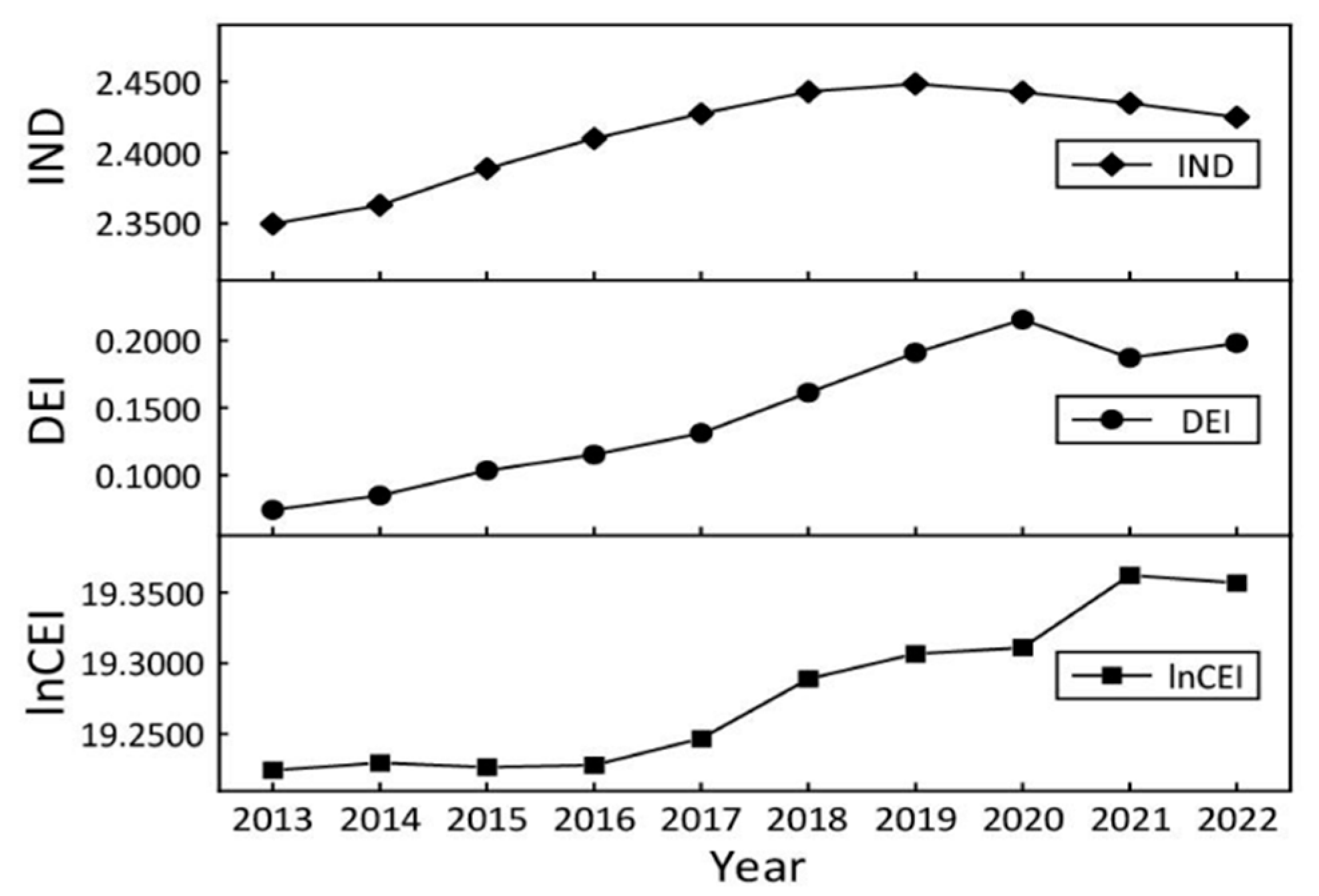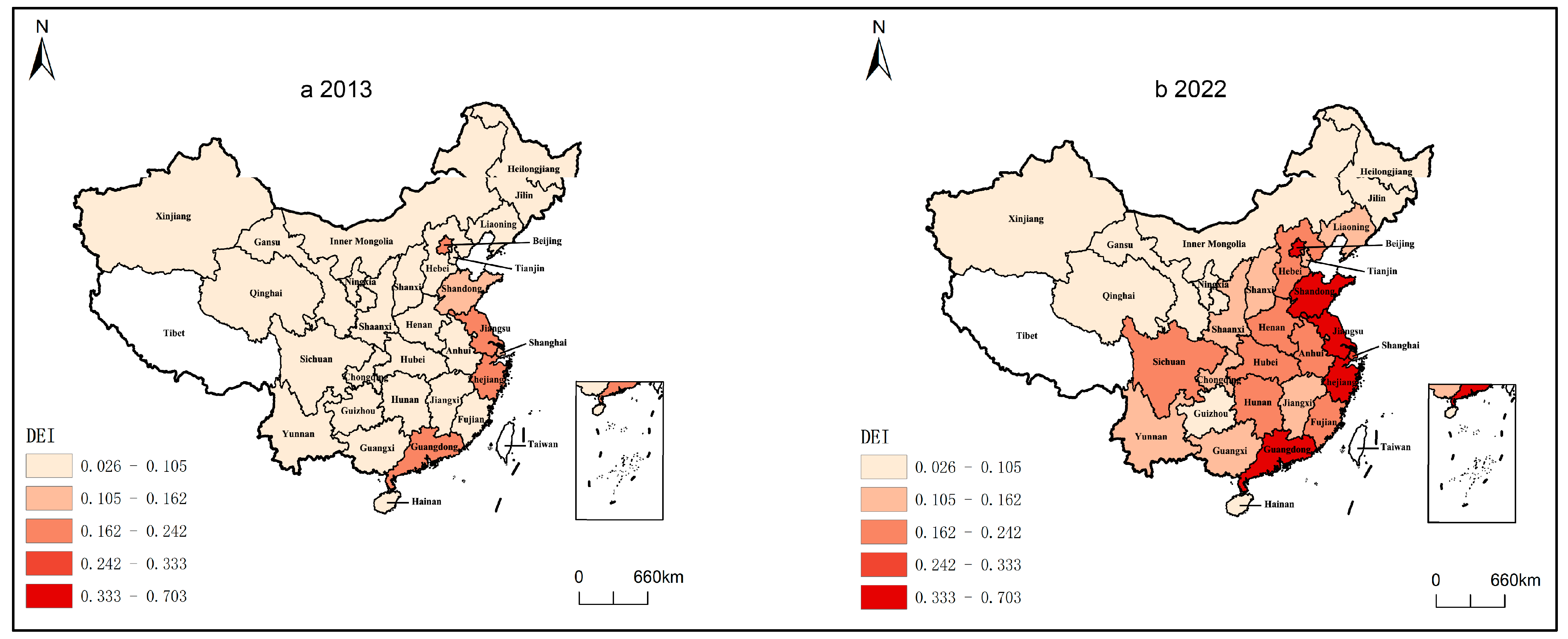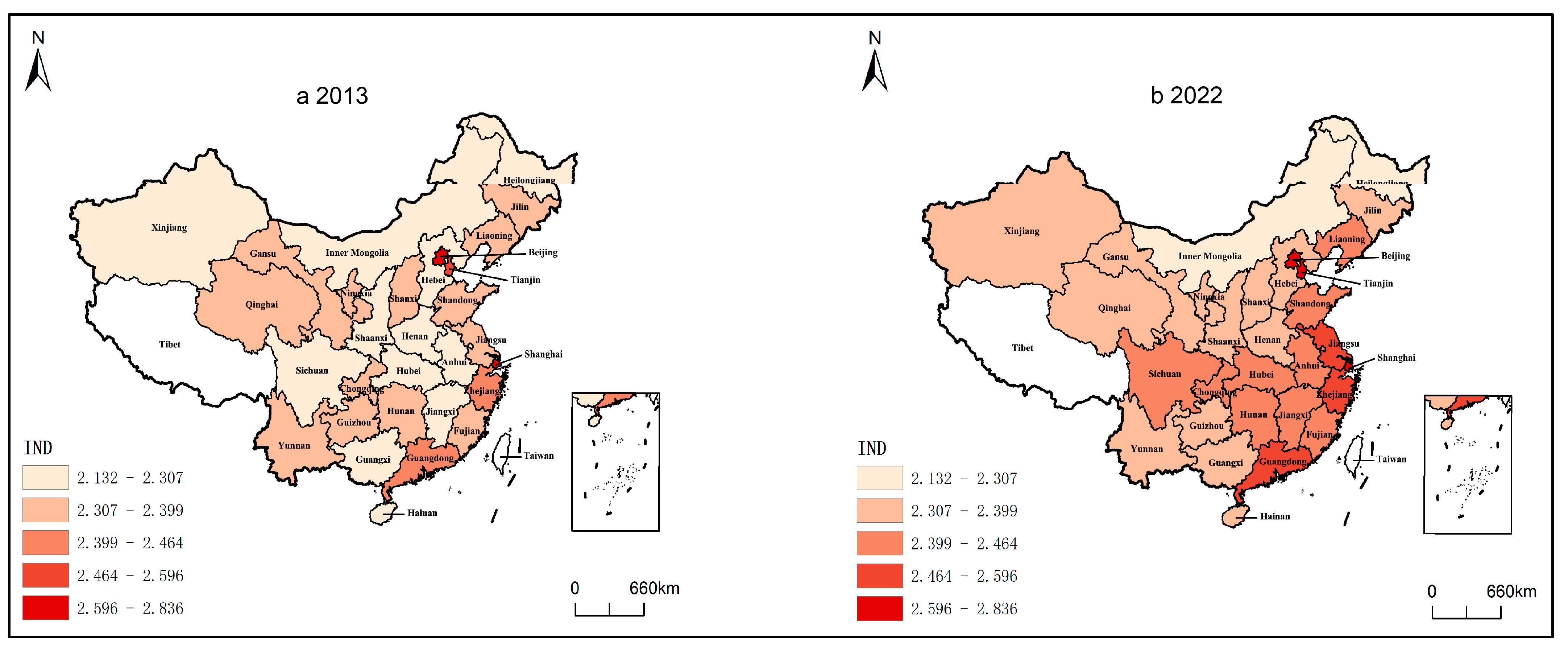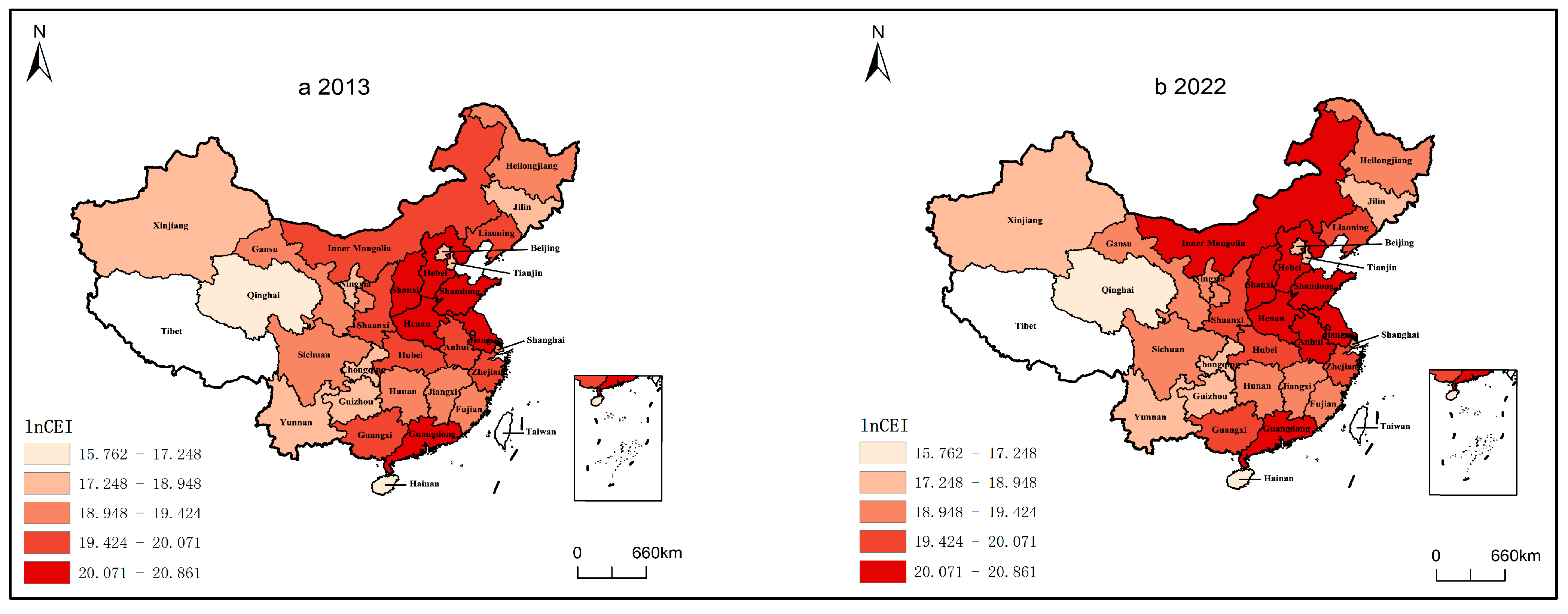Unraveling the Triple Nexus of the Digital Economy, Industrial Transformation, and Carbon Emissions: Evidence from China
Abstract
1. Introduction
- (1)
- What are the spatiotemporal differentiation patterns of the digital economy, industrial restructuring, and carbon emissions across Chinese provinces from 2013 to 2022?
- (2)
- How do these three systems co-evolve and interact, as measured through a modified coupling coordination degree model and Exploratory Spatial Data Analysis?
- (3)
- What are the dynamic interaction mechanisms among these systems, as examined using a Panel Vector Autoregression model combined with GMM estimation, impulse response functions, and variance decomposition?
2. Research Method and Data
2.1. Research Framework
2.2. Indicator Measurement
2.2.1. Measurement of Digital Economy Index
2.2.2. Measurement of Industrial Structure Transformation
2.2.3. Measurement of Carbon Emissions
2.3. Coupling Coordination Degree Model
- (1)
- It addresses the boundary problem that arises when one subsystem takes a value of zero. In the conventional formulation, when one subsystem takes a value of zero, the overall coupling degree also collapses to zero (e.g., C(1,1,1,0) = 0), even if the remaining subsystems exhibit strong interdependence. This distortion misrepresents the actual level of system coordination. To correct this, the improved model introduces a two-step normalization and boundary-adjustment mechanism. First, all subsystem indices are standardized within the range (0, 1] to eliminate dimensional bias. Second, a distance-based boundary adjustment is applied to differentiate the relative contributions of each subsystem and to maintain valid coupling results even when one subsystem approaches zero. This procedure ensures both the mathematical continuity and the comparability of the coupling coefficient across multi-dimensional systems, thereby providing a more realistic reflection of inter-system coordination.
- (2)
- It removes the conceptual overlap between coupling and coordination by defining the coupling degree purely as a measure of relative deviation, while the coordination index reflects the integrated level of overall development. Through this separation, the model captures the dispersion of subsystem development independently from the magnitude of their joint progress.
- (3)
- It enhances the discriminative power and stability of the coupling results, particularly in multi-dimensional systems, ensuring that variations in subsystem performance are more precisely identified. This refinement improves the sensitivity of the model to small differences in subsystem development levels, resulting in more robust and interpretable coupling outcomes.
2.4. ESDA Model
2.5. PVAR Model
2.6. Data Sources
3. Results and Discussion
3.1. Spatiotemporal Evolution Characteristics of DEI, IND, and lnCEI
3.1.1. Temporal Evolution Characteristics of DEI, IND, and lnCEI
3.1.2. Spatial Evolution Characteristics of DEI, IND, and lnCEI
3.2. Analysis of Coupling Coordination Relationships
3.2.1. Temporal Evolution Characteristics of Coupling Coordination Degree
3.2.2. Spatial Evolution Characteristics of D-I-C Coupling Coordination Degree
3.3. Spatial Correlation Analysis of Coupling Coordination Degree
3.3.1. Global Spatial Autocorrelation
3.3.2. Local Spatial Autocorrelation
3.4. Interaction Effects Analysis of DEI, IND, and lnCEI
3.4.1. Unit Root Test
3.4.2. Optimal Lag Order Selection
3.4.3. GMM Model Estimation
3.4.4. Granger Causality Test
3.4.5. Robustness Test
3.4.6. Impulse Response Analysis
3.4.7. Variance Decomposition
4. Policy Implications and Conclusions
4.1. Conclusions
4.2. Policy Implications
- (1)
- Foster integrated digital–industrial development. The government should promote digital infrastructure deployment in traditional industries, facilitating data-driven production and efficiency improvement to support low-carbon transformation.
- (2)
- Adopt region-specific coordination strategies. The eastern region should continue to drive digital and technological innovation, while the central and western regions require targeted support to enhance cross-system coordination and reduce development gaps.
- (3)
- Strengthen data-driven carbon governance. Building unified digital carbon platforms and improving carbon information disclosure can enhance emission monitoring and transparency, helping to link digital progress with environmental governance.
- (4)
- Encourage innovation–emission reduction linkage. Policymakers should promote the integration of digital technologies with clean production and green innovation, fostering a positive feedback cycle that supports sustainable and inclusive growth.
Author Contributions
Funding
Data Availability Statement
Acknowledgments
Conflicts of Interest
References
- Ma, Q.; Mentel, G.; Zhao, X.; Salahodjaev, R.; Kuldasheva, Z. Natural resources tax volatility and economic performance: Evaluating the role of digital economy. Resour. Policy 2022, 75, 102510. [Google Scholar] [CrossRef]
- Bai, T.; Qi, Y.; Li, Z.; Xu, D. Digital economy, industrial transformation and upgrading, and spatial transfer of carbon emissions: The paths for low-carbon transformation of Chinese cities. J. Environ. Manag. 2023, 344, 118528. [Google Scholar] [CrossRef] [PubMed]
- Li, D.; Liu, Y.; Zhang, L.; Zheng, Z. Digital economy development and trade credit supply: Evidence from Chinese A-Share listed firms. Res. Int. Bus. Financ. 2025, 77, 102900. [Google Scholar] [CrossRef]
- Huang, C.; Lin, B. Digital economy solutions towards carbon neutrality: The critical role of energy efficiency and energy structure transformation. Energy 2024, 306, 132524. [Google Scholar] [CrossRef]
- Zeng, G.; Wu, M.; Yuan, X. Digital economy and industrial agglomeration. Econ. Anal. Policy 2024, 84, 475–498. [Google Scholar] [CrossRef]
- Mehmood, S.; Zaman, K.; Khan, S.; Ali, Z.; Khan, H.U.R. The role of green industrial transformation in mitigating carbon emissions: Exploring the channels of technological innovation and environmental regulation. Energy Built Environ. 2024, 5, 464–479. [Google Scholar] [CrossRef]
- Huo, D.; Yang, H.; Zhou, X.; Kang, W. Key industrial sectors and their evolutionary trends in China’s embodied carbon emission network. Alex. Eng. J. 2025, 123, 249–260. [Google Scholar] [CrossRef]
- Feng, Z.; Sun, Y.; Ning, J.; Tang, S.; Liu, G.; Liu, F.; Li, Y.; Shi, L. Implementing a provincial-level universal daily industrial carbon emissions prediction by fine-tuning the large language model. Appl. Energy 2025, 383, 125372. [Google Scholar] [CrossRef]
- Zhu, Q.; Geng, Y.; Lai, K.-H. Circular economy practices among Chinese manufacturers varying in environmental-oriented supply chain cooperation and the performance implications. J. Environ. Manag. 2010, 91, 1324–1331. [Google Scholar] [CrossRef]
- Han, Y.; Wei, T. Supply chain digitization and corporate carbon emissions: A chain mediation examination based on digital transformation and green innovation. J. Environ. Manag. 2025, 379, 124825. [Google Scholar] [CrossRef]
- Wang, M.; Qin, K.; Li, J.; Yang, S. Explaining the transmission mechanism of social-ecological systems adaptive cycling on path dependency in resource-based cities: Evidence from Shanxi Province, China. Sustain. Futures 2025, 9, 100449. [Google Scholar] [CrossRef]
- Li, Y.; Chen, Y.; Wang, Y. Grey forecasting the impact of population and GDP on the carbon emission in a Chinese region. J. Clean. Prod. 2023, 425, 139025. [Google Scholar] [CrossRef]
- Zhang, Y.; Khan, S.U.; Wang, Y. The future is digital: Can the digital economy drive marine sustainability? Exploring regional impacts on fisheries’ carbon emissions in coastal China. J. Clean. Prod. 2025, 506, 145518. [Google Scholar] [CrossRef]
- Zhu, Q.; Xu, C.; Wu, L.; Fang, X.; Pan, Y.; Zhou, D. Enhancing sustainability: Assessing the low-carbon impact of China’s digital economy on residential carbon emissions. Environ. Dev. 2025, 54, 101161. [Google Scholar] [CrossRef]
- Zhou, D.; Chu, J. The carbon emission reduction effect of the digital economy from the perspective of biased technological progress. J. Environ. Manag. 2025, 373, 123857. [Google Scholar] [CrossRef] [PubMed]
- Ma, Y.; Li, R. The impact of digital economy on carbon emissions: Insights from the G-20 energy transition and environmental governance. Energy Strategy Rev. 2025, 57, 101612. [Google Scholar] [CrossRef]
- Wang, H.; Yang, G.; Yue, Z. Breaking through ingrained beliefs: Revisiting the impact of the digital economy on carbon emissions. Humanit. Soc. Sci. Commun. 2023, 10, 609. [Google Scholar] [CrossRef]
- Hong, C.; Ding, Q.; Zhao, W.; Hou, N.; Liu, W. The digital economy, industrial structure upgrading, and carbon emission intensity—Empirical evidence from China’s provinces. Energy Strategy Rev. 2023, 50, 101218. [Google Scholar] [CrossRef]
- Dong, B.; Ma, X.; Zhang, Z.; Zhang, H.; Chen, R.; Song, Y.; Shen, M.; Xiang, R. Carbon emissions, the industrial structure and economic growth: Evidence from heterogeneous industries in China. Environ. Pollut. 2020, 262, 114322. [Google Scholar] [CrossRef]
- Li, X.; Yue, S. Does the government digital attention improve China’s digital economy output efficiency: Accelerator or inhibitor. Econ. Anal. Policy 2025, 85, 607–625. [Google Scholar] [CrossRef]
- Cheng, D.; Guo, X.; Guo, Y. Research on the mechanism of digital economy enabling the conversion of new and old kinetic energy. Energy Policy 2025, 202, 114590. [Google Scholar] [CrossRef]
- Di, K.; Chen, W.; Zhang, X.; Shi, Q.; Cai, Q.; Li, D.; Liu, C.; Di, Z. Regional unevenness and synergy of carbon emission reduction in China’s green low-carbon circular economy. J. Clean. Prod. 2023, 420, 138436. [Google Scholar] [CrossRef]
- Yuan, H.; Zhu, C.L. Has the national high-tech zone promoted the transformation and upgrading of China’s industrial structure? China Ind. Econ. 2018, 8, 60–77. [Google Scholar] [CrossRef]
- Zhang, X.Y.; Xie, L.H.; Xiao, J.H. Government procurement, digital economy development, and industrial structure upgrading. Contemp. Financ. Econ. 2024, 3, 43–55. [Google Scholar] [CrossRef]
- Liu, X.; Ji, K.; Sun, Y.; Lu, J. Unveiling the nonlinear impact: Green finance, carbon emission intensity, and digital economy integration. Sustain. Futures 2025, 9, 100610. [Google Scholar] [CrossRef]
- Cai, A.; Guo, R.; Zhang, Y.; Wang, L.; Lin, R.; Wu, H.; Huang, R.; Zhang, J.; Wu, J. Assessing urban carbon health in China’s three largest urban agglomerations: Carbon emissions, energy-carbon emission efficiency and carbon sinks. Appl. Energy 2025, 383, 125326. [Google Scholar] [CrossRef]
- Lu, F.; Ma, F.; Feng, L. Carbon dioxide emissions and economic growth: New evidence from GDP forecasting. Technol. Forecast. Soc. Chang. 2024, 205, 123464. [Google Scholar] [CrossRef]
- Sun, X.; Shao, H.; Liang, S.; Zhou, Y.; Dai, X.; Liu, M.; Tao, R.; Guo, Z.; Xin, Q. Tracking sustainable development in mining towns: A novel framework integrating socioeconomic and eco-environmental perspectives through coupling coordination degree. Environ. Impact Assess. Rev. 2024, 109, 107641. [Google Scholar] [CrossRef]
- Wang, Y.; Guo, L.; Wang, Y.; Zhang, Y.; Zhang, S.; Liu, Z.; Xing, J.; Liu, X. Bi-level programming optimization method of rural integrated energy system based on coupling coordination degree of energy equipment. Energy 2024, 298, 131289. [Google Scholar] [CrossRef]
- Wang, S.J.; Kong, W.; Ren, L.; Zhi, D.D.; Dai, B.T. Misconceptions and revisions of the coupling coordination degree model in China. J. Nat. Resour. 2021, 36, 793–810. [Google Scholar] [CrossRef]
- Fan, D.J.; Ke, H.; Cao, R.M. Revision and improvement of the coupling coordination degree model. Stat. Decis. 2024, 40, 41–46. [Google Scholar] [CrossRef]
- Yu, T.; Zhang, Y.; Jia, S.; Cui, X. Spatio-temporal evolution and drivers of coupling coordination between digital infrastructure and inclusive green growth: Evidence from the Yangtze River economic belt. J. Environ. Manag. 2025, 376, 124416. [Google Scholar] [CrossRef] [PubMed]
- Zhao, G.; Liang, R.; Li, K.; Wang, Y.; Pu, X. Study on the coupling model of urbanization and water environment with basin as a unit: A study on the Hanjiang Basin in China. Ecol. Indic. 2021, 131, 108130. [Google Scholar] [CrossRef]
- Li, W.; Cui, W.; Yi, P. Digital economy evaluation, regional differences and spatio-temporal evolution: Case study of Yangtze River economic belt in China. Sustain. Cities Soc. 2024, 113, 105685. [Google Scholar] [CrossRef]
- Li, J.; Liu, W.; Du, L.; Xiao, J. High-tech industry agglomeration and regional green development: An analysis of spatial Durbin model. Technol. Forecast. Soc. Chang. 2024, 205, 123372. [Google Scholar] [CrossRef]
- Huang, D.; Xu, G.; Li, C.; Yang, S. Effects of high-tech industrial agglomeration and innovation on regional economic development in China: Evidence from spatial-temporal analysis and Spatial Durbin Model. Econ. Anal. Policy 2025, 86, 692–712. [Google Scholar] [CrossRef]
- Wang, Y.; Su, Z.; Cai, X.; Yu, J. The dual carbon emission effects of digital economy: Evidence from China. Heliyon 2025, 11, e42554. [Google Scholar] [CrossRef]
- Han, X.; Wang, Y.; Yu, W.; Xia, X. Coupling and coordination between green finance and agricultural green development: Evidence from China. Financ. Res. Lett. 2023, 58, 104221. [Google Scholar] [CrossRef]
- Hu, Z.; Kumar, J.; Qin, Q.; Kannan, S. Assessing the coupling coordination degree between all-for-one tourism and ecological civilization; case of Guizhou, China. Environ. Sustain. Indic. 2023, 19, 100272. [Google Scholar] [CrossRef]
- Li, Y.; Zhou, B. Coupling coordination degree measurement and spatial characteristics analysis of green finance and technological innovation: Empirical analysis based on China. Heliyon 2024, 10, e33486. [Google Scholar] [CrossRef]
- He, C.; Sheng, H.; Dai, X. The “Point-Axis System” theory continues to empower China’s major regional strategies. Acta Geogr. Sin. 2024, 79, 2972–2990. [Google Scholar] [CrossRef]
- Jiang, W.; Li, J. Digital transformation and its effect on resource allocation efficiency and productivity in Chinese corporations. Technol. Soc. 2024, 78, 102638. [Google Scholar] [CrossRef]
- Huang, C.; Lin, B. The impact of digital economy on energy rebound effect in China: A stochastic energy demand frontier approach. Energy Policy 2025, 196, 114418. [Google Scholar] [CrossRef]
- Liu, Y.; Liu, N.; Huo, Y. Impact of digital technology innovation on carbon emission reduction and energy rebound: Evidence from the Chinese firm level. Energy 2025, 320, 135187. [Google Scholar] [CrossRef]
- Abrigo, M.R.M.; Love, I. Estimation of panel vector autoregression in Stata. Stata J. 2016, 16, 778–804. [Google Scholar] [CrossRef]
- Zouaoui, H.; Zoghlami, F. On the income diversification and bank market power nexus in the MENA countries: Evidence from a GMM panel-VAR approach. Res. Int. Bus. Financ. 2020, 52, 101186. [Google Scholar] [CrossRef]










| Variable | Primary Indicator | Secondary Indicator | Tertiary Indicator |
|---|---|---|---|
| Internet Broadband Access | Number of Internet broadband access ports/regional resident population | ||
| Internet Broadband Penetration | Number of Internet broadband subscribers/regional resident population | ||
| Digital Infrastructure | Mobile Telecommunication Facilities | Capacity of mobile telephone switches | |
| Long-Distance Optical Cable Length | Length of long-distance optical cables | ||
| Web page Count | Number of web pages | ||
| Domain Name Count | Number of domain names | ||
| Per Capita Telecom Service Volume | Total telecom business volume/regional resident population | ||
| Mobile Phone Penetration Rate | Mobile phone penetration rate | ||
| Digital Economy | Digital Industrialization | ICT Sector Legal Entity Count | Number of legal entities in information transmission, software, and IT services |
| ICT Employment Share | ICT sector urban employees/total urban employees | ||
| Domestic Patent Grants | Number of domestically granted patents | ||
| Domestic Patent Applications | Number of domestically filed patent applications | ||
| Peking University Digital Inclusive Finance Index | Peking University Digital Inclusive Finance Index | ||
| Proportion of E-commerce Enterprises | Share of enterprises with e-commerce transactions | ||
| E-commerce Sales Volume | E-commerce sales revenue | ||
| Industrial Digitization | Websites per 100 Enterprises | Number of websites per 100 enterprises | |
| Secondary & Tertiary Industry Value-Added | Value-added of secondary industry + tertiary industry | ||
| R&D Investment in Science & Technology | Industrial enterprise R&D expenditure | ||
| Express Delivery Volume | Volume of express deliveries |
| DATA Type | Indicator Description | Source | Access Link |
|---|---|---|---|
| DEI | Measures provincial digital development through digital infrastructure, digital industrialization, and industrial digitalization. | Peking University Digital Inclusive Finance Index Database; CSMAR Database; CNRDS Database; Qichacha Database | https://idf.pku.edu.cn/ (accessed on 12 April 2025); https://data.csmar.com/ (accessed on 18 April 2025); https://www.cnrds.com/ (accessed on 18 April 2025); https://www.qcc.com/ (accessed on 3 May 2025) |
| IND | IND = (Primary industry added value/GDP) × 1 + (Secondary industry added value/GDP) × 2 + (Tertiary industry added value/GDP) × 3. | China Statistical Yearbook; Provincial Statistical Yearbooks | https://data.stats.gov.cn/ (accessed on 7 May 2025) |
| lnCEI | Total CO2 emissions, converted to logarithmic form; based on energy consumption and emission coefficients. | Emissions Database for Global Atmospheric Research | https://edgar.jrc.ec.europa.eu/ (accessed on 11 May 2025) |
| CCD Value Range | Coupling Coordination Type |
|---|---|
| 0.0 < D ≤ 0.2 | Low coupling coordination |
| 0.2 < D ≤ 0.5 | Moderate coupling coordination |
| 0.5 < D ≤ 0.8 | High coupling coordination |
| 0.8 < D < 1.0 | Extreme coupling coordination |
| Year | Moran’s I | Z Score | p Value |
|---|---|---|---|
| 2013 | 0.1345 | 3.2621 | 0.0011 |
| 2014 | 0.1356 | 3.3164 | 0.0009 |
| 2015 | 0.1236 | 3.1333 | 0.0017 |
| 2016 | 0.1241 | 3.1321 | 0.0017 |
| 2017 | 0.1206 | 3.0547 | 0.0023 |
| 2018 | 0.0988 | 2.6654 | 0.0077 |
| 2019 | 0.0646 | 1.9894 | 0.0467 |
| 2020 | 0.0543 | 1.7667 | 0.0773 |
| 2021 | 0.0832 | 2.3934 | 0.0167 |
| 2022 | 0.0838 | 2.3796 | 0.0173 |
| Variable | LLC | IPS | ADF-Fisher | PP-Fisher |
|---|---|---|---|---|
| DEI | −6.973 *** | −2.371 *** | 3.152 *** | −0.711 |
| dDEI | −13.740 *** | −4.884 *** | 8.790 *** | 7.391 *** |
| IND | −12.266 *** | −0.899 | 6.377 *** | −1.853 |
| dIND | −17.632 *** | −5.797 *** | 16.739 *** | 8.372 *** |
| lnCEI | −15.678 *** | −1.284 * | 12.139 *** | 0.844 |
| dlnCEI | −12.204 *** | −5.149 *** | 8.062 *** | 4.198 *** |
| Lag | MBIC | MAIC | MQIC |
|---|---|---|---|
| 1 | −72.786 | 2.477 | −28.088 |
| 2 | −45.908 | 4.267 | −16.109 |
| 3 | −34.922 | −9.834 | −20.022 |
| Variable | dDEI | dIND | dlnCEI |
|---|---|---|---|
| L.dDEI | 0.249 *** | 0.07 | 0.350 ** |
| (0.09) | (0.05) | (0.14) | |
| L.dIND | 0.423 *** | 0.682 *** | −0.344 *** |
| (0.07) | (0.07) | (0.13) | |
| L.dlnCEI | 0.139 *** | 0.008 | 0.210 *** |
| (0.03) | (0.03) | (0.07) |
| Equation | Excluded | p-Value | Results |
|---|---|---|---|
| dIND | 0.000 | Reject | |
| dDEI | dnCEI | 0.000 | Reject |
| ALL | 0.000 | Reject | |
| dDEI | 0.170 | Accept | |
| dIND | dlnCEI | 0.805 | Accept |
| ALL | 0.338 | Accept | |
| dDEI | 0.010 | Reject | |
| dlnCEI | dIND | 0.010 | Reject |
| ALL | 0.005 | Reject |
| Response Variable | Impact Variable | |||
|---|---|---|---|---|
| Period | dDEI | dIND | dlnCEI | |
| dDEI | 10 | 0.731 | 0.212 | 0.057 |
| dDEI | 20 | 0.730 | 0.213 | 0.057 |
| dDEI | 30 | 0.730 | 0.213 | 0.057 |
| dIND | 10 | 0.044 | 0.953 | 0.003 |
| dIND | 20 | 0.044 | 0.953 | 0.003 |
| dIND | 30 | 0.044 | 0.953 | 0.003 |
| lnCEI | 10 | 0.068 | 0.028 | 0.904 |
| lnCEI | 20 | 0.068 | 0.028 | 0.904 |
| lnCEI | 30 | 0.068 | 0.028 | 0.904 |
Disclaimer/Publisher’s Note: The statements, opinions and data contained in all publications are solely those of the individual author(s) and contributor(s) and not of MDPI and/or the editor(s). MDPI and/or the editor(s) disclaim responsibility for any injury to people or property resulting from any ideas, methods, instructions or products referred to in the content. |
© 2025 by the authors. Licensee MDPI, Basel, Switzerland. This article is an open access article distributed under the terms and conditions of the Creative Commons Attribution (CC BY) license (https://creativecommons.org/licenses/by/4.0/).
Share and Cite
Ding, H.; Tian, Y. Unraveling the Triple Nexus of the Digital Economy, Industrial Transformation, and Carbon Emissions: Evidence from China. Sustainability 2025, 17, 9888. https://doi.org/10.3390/su17219888
Ding H, Tian Y. Unraveling the Triple Nexus of the Digital Economy, Industrial Transformation, and Carbon Emissions: Evidence from China. Sustainability. 2025; 17(21):9888. https://doi.org/10.3390/su17219888
Chicago/Turabian StyleDing, Hongyuan, and Yuan Tian. 2025. "Unraveling the Triple Nexus of the Digital Economy, Industrial Transformation, and Carbon Emissions: Evidence from China" Sustainability 17, no. 21: 9888. https://doi.org/10.3390/su17219888
APA StyleDing, H., & Tian, Y. (2025). Unraveling the Triple Nexus of the Digital Economy, Industrial Transformation, and Carbon Emissions: Evidence from China. Sustainability, 17(21), 9888. https://doi.org/10.3390/su17219888





